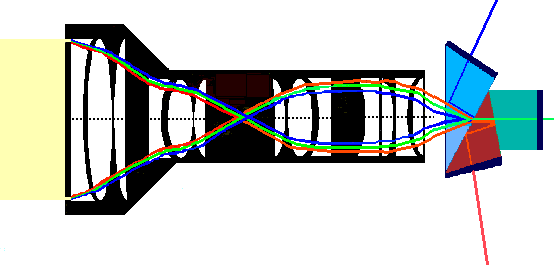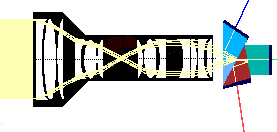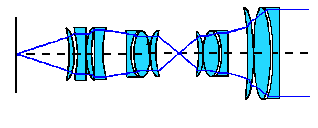




|
| ||||||||||||||||||||
 | If parallel rays of light pass through a convex lens, they will converge to a single point on the optical axis. This point is called the focal point or focal plain of the lens. The focal length of a fixed focal length lens is indicated by the distance from the center of the lens to the focal point/plain. A lens has two focal points, one on the object side, called the primary focal point, and one on the image side, called the secondary focal point. When the term "focal point', is used alone, it means the secondary focal point. The lenses used on video cameras are compound lenses, consisting of several individual lenses combined so as to correct "aberrations". However, they function like a single lens located at an imaginary point called the "principal point". The focal length is the basic factor used to calculate the image position and magnification of a lens. The focal length of a video lens is important as a parameter describing the angle of view of the lens. The focal length and "principal point" of a zoom lens are changed by zooming, so as you zoom, you change the angle of view of the lens. A short focal length gives a wide angle of view, and a long focal length gives a narrow angle of view, which causes the image to be magnified. | ||||||||||||||||||||
| Lens specifications contain a large quantity of figures/specifications. To interpret them and to tell whether the lens is right for a specific purpose, requires some basic knowledge of optics. | |||||||||||||||||||||
| |||||||||||||||||||||
| The first item to check in the specifications is the image size. There is no point fitting a 1/2" lens on a 2/3" camera. The image it forms is too small, the image will cover the complete area of the image sensor. The image formed by the lens is round, not rectangular. The range of the image is called the "image circle". In a video camera, the CCD sensor occupies a rectangular area, which touches the "image circle". The size of the image sensor is the actual image size. Current video cameras use two main sizes of image sensors, with one minor size not commonly used. There are also two main series of zoom lenses, one for each image size. The first letter of the lens designation indicates the image size. The ratio of the width of the screen to the height of the screen is called the aspect ratio. In most standard definition television it is usually 4:3. The wide screen standard definition television and high definition aspect ratio is 16:9, which more closely resembles the film aspect ratio. | |||||||||||||||||||||
| |||||||||||||||||||||
| The zoom ratio is the ratio of the focal length at the telephoto end of the zoom to the focal length at the wide-angle end. The zoom ratio indicates how much the size of the image on the monitor can be changed. If a zoom lens has a zoom ratio of lOx, the image it gives at the telephoto end will be magnified exactly 10 times as much as the image at the wide-angle end. You can use the model numbers on the lens to determine it's zoom ratio. An A16X8.5 or J16X8.5 is essentially, at the telephoto end, 16 times 8.5 millimeters. |
| ||||||||||||||||||||
| The larger the zoom ratio is, the more the size of the image can be changed. It is important to select an appropriate zoom ratio. A large zoom ratio is desirable, but it also makes the lens bigger and heavier. |
| ||||||||||||||||||||
| |||||||||||||||||||||
 | |||||||||||||||||||||
| |||||||||||||||||||||
| If you have zoomed with a zoom lens open to full aperture, you may have noted a drop in video level at the telephoto end. This is called the F drop or "ramping". The "entrance pupil" of a zoom lens changes in diameter as the focal length is changed. As you zoom toward the telephoto end, the entrance pupil gradually enlarges. When the entrance pupil diameter is equal to the diameter of the focusing lens group, it can not become any larger, so the F-stop drops. That is the reason for the F drop. To eliminate F drop completely, the focusing lens group, (the elements in the front of the lens), has to be larger than the entrance pupil at the telephoto end of the zoom. It has to be at least equal to the focal length at the telephoto end divided by the F-number. To reduce the size and weight of a zoom lens to make it easy to use for hand held cameras, we have a trade off that makes it common to have a certain amount of F drop or ramping at the telephoto end. For better composition effect, however, in some studio zoom lenses the focusing group is made large enough that no F drop occurs. F drop is a major determinant of the value of zoom lenses used in live on-site sports broadcasts, which require a long focal length and must frequently contend with twilight or inadequate artificial illumination. As many people know, movie camera lenses are rated by a T-number instead of an F-stop.The F-stop expresses the speed of the lens on the assumption that lens transmits 1OO% of the incident light. In reality, different lenses have different transmittance, so two lenses with the same F-stop may actually have different speed. The T-number solves this problem by taking both the diaphragm diameter and transmittance into account. Two lenses with the same T number will always give the same brightness. | |||||||||||||||||||||
| |||||||||||||||||||||
| A television camera contains a beam splitting prism, filters, and other glass blocks. Its lens has to be corrected so that it will deliver optimum performance when these glass blocks are inserted. Different television cameras have different beam-splitting prisms, so the lens glass compensation has to be matched to the type of camera. Currently, most camera manufacturers have standardized their 2/3" prism compensation and design for their entier line of 2/3" cameras. This allows for camera matching between the studio type and the hand held cameras and allows a user to combine both types of cameras for a production. When the prism mounted behind the lens differs from the designed glass compensation, the main effects are increased spherical aberration and longitudinal chromatic aberration. Longitudinal chromatic aberration caused by different glass material the letters and numbers at the end of the lens designation indicate the glass compensation type. If the designation is 18x9134, for example, the letter B indicates that the lens is glass compensated, and the number that follows indicates the type of compensation. | |||||||||||||||||||||
| |||||||||||||||||||||
| This form of aberration causes the different color wavelengths to focus on different image planes. It corresponds to the lens tracking error. In a zoom lens, the amount of the longitudinal chromatic aberration varies as the lens is zoomed. The aberration is largest at the telephoto end. If corrections for longitudinal chromatic aberrations are not put in the lens, a color tracking error will occur on the red and blue channels. This will cause color blurring, even when the lens tracking adjustment is optimal. In a long-focal-length, high zoom ratio lens, chromatic aberration is the greatest problem, particularly with the secondary spectrum, which is a high-order chromatic aberration. The chromatic aberration of a lens is usually corrected at two wavelengths. The secondary spectrum is the residual chromatic aberration left at the wavelength midway between these two. | Lateral chromatic aberration occurs because the magnification of the image differs with the various color wavelengths. In a video camera it causes what appears to be a registration error. Lateral chromatic aberration also has a secondary chromatic aberration, making it difficult to correct all three of the red, blue and green wavelengths at the same time. | ||||||||||||||||||||
| Two-wavelength correction is inadequate in a television camera that has three (red, blue, and green) channels. The secondary spectrum also has to be corrected. The main cause of the problem is the residual chromatic aberration of the focusing group of lenses. It is difficult to solve because of inherent limits in the dispersion (wavelength characteristic of refractive index) of optical glass. The secondary spectrum of many manufacturers lenses is corrected by using fluorite crystal, which has a better dispersion than ordinary optical glass. This is why many lenses appear to have a tinted front element that differs by manufacturer. |  | ||||||||||||||||||||
| This has been some basic and advanced information regarding video lenses, and why we see what appear to be problems with our lenses on occasion. From what we have heard from the various manufacturers of cameras, the capability of the current generation of cameras out performs the current generation of lenses. And with CCD cameras, it's harder to make a lens that focuses all three channels on one focal plane at a time, throughout the entire zoom range. This is why you may see more abberations with your lens currently, while a few years ago you wouldn't see a thing. Hopefully this little bit of lens information is interesting to you, and makes a bit of sense. If you have any questions, please feel free to write us. Keep shooing out there!
| |||||||||||||||||||||
 | |||||||||||||||||||||
| Updates on Lens Theory - Camera Dave - 1999 | |||||||||||||||||||||